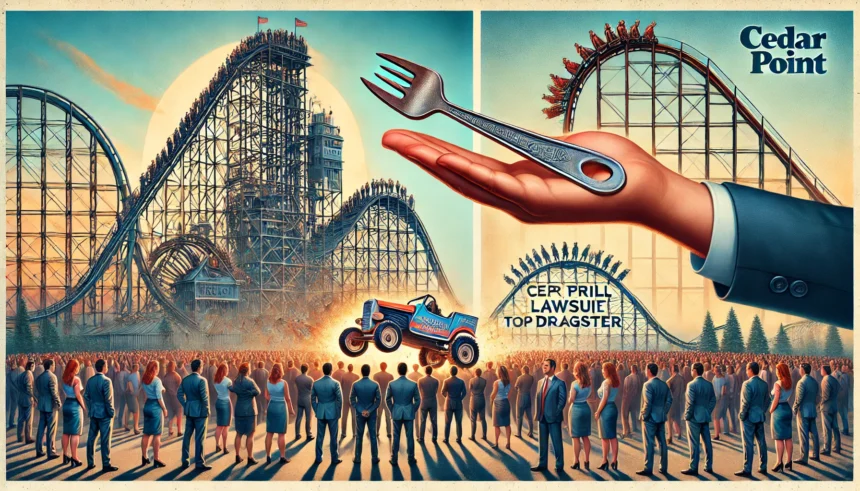The Cedar Point lawsuit involving the Top Thrill Dragster was initiated following a serious incident that raised concerns about rider safety. The lawsuit stems from an accident that occurred in August 2021, where a metal piece reportedly struck a rider, resulting in significant injuries.
This incident prompted investigations by both the park and regulatory authorities. As a result, the ride was closed indefinitely, and the legal implications for the park have been significant. The lawsuit not only seeks compensation for the injured party but also aims to address broader safety concerns at amusement parks.
The case has garnered media attention, highlighting the responsibilities of amusement parks to ensure the safety of their rides. As the legal proceedings unfold, they may set important precedents for future cases involving amusement park safety.
Key Factors in the Cedar Point Lawsuit Top Thrill Dragster
Several key factors will influence the Cedar Point lawsuit concerning the Top Thrill Dragster. First, establishing the cause of the incident is crucial. Investigators will need to determine whether the ride’s design, maintenance, or operation contributed to the accident.
- Ride Maintenance Records: Documentation of regular inspections and maintenance will be critical in assessing the park’s responsibility.
- Witness Testimonies: Accounts from other riders and employees present during the incident can provide valuable insights.
- Safety Protocols: Understanding the safety measures in place at the time of the incident will also play a significant role in the legal proceedings.
These factors will help determine liability and influence the potential outcomes of the lawsuit.
Common Legal Considerations in the Cedar Point Lawsuit Top Thrill Dragster
In the Cedar Point lawsuit involving the Top Thrill Dragster, several common legal considerations are at play. One of the most significant is the statute of limitations, which sets a deadline for filing a claim. In Ohio, where Cedar Point is located, the general statute of limitations for personal injury claims is two years from the date of the incident.
Another important consideration is the burden of proof. The injured party must demonstrate that Cedar Point was negligent in its duty to provide a safe ride environment. This includes showing that the park failed to uphold industry standards or that they did not maintain the ride properly.
| Legal Consideration | Description | Importance |
| Statute of Limitations | Time limit for filing claims | Critical for preserving legal rights |
| Burden of Proof | Responsibility to prove negligence | Essential for a successful case |
| Negligence Standards | Industry standards for ride safety | Impacts liability and compensation |
Understanding these legal considerations is crucial for all parties involved in the lawsuit.
Impact of the Cedar Point Lawsuit Top Thrill Dragster on Amusement Park Safety
The Cedar Point lawsuit regarding the Top Thrill Dragster has significant implications for amusement park safety. As the legal case unfolds, it may lead to increased scrutiny of safety protocols across the industry.
If the lawsuit reveals negligence or inadequate safety measures, it could prompt regulatory changes that affect how amusement parks operate. This could include stricter guidelines for ride maintenance, regular safety audits, and enhanced training for staff.
Furthermore, the outcome may influence public perception of ride safety. A high-profile lawsuit can lead to increased consumer wariness regarding amusement park attractions, potentially affecting attendance and revenue.
In summary, the implications of this lawsuit extend beyond Cedar Point, impacting the broader amusement park industry.
Safety Regulations for Amusement Park Rides
Safety regulations for amusement park rides are designed to protect patrons from harm. These regulations vary by state but generally include guidelines for ride design, maintenance, and operation.
Amusement parks must comply with state and federal safety standards, which are enforced by regulatory bodies. Regular inspections and maintenance are critical components of these safety regulations, ensuring that rides are functioning properly and are safe for public use.
- Design Standards: Rides must be designed with safety features to minimize risk.
- Operational Procedures: Staff must be trained to operate rides safely and respond to emergencies.
- Maintenance Protocols: Regular maintenance checks are required to identify and address potential issues.
These regulations play a vital role in preventing accidents and ensuring a safe environment for riders.
Comparing the Cedar Point Lawsuit Top Thrill Dragster to Other Ride Incidents
When comparing the Cedar Point lawsuit involving the Top Thrill Dragster to other ride incidents, several similarities and differences emerge. Many amusement park lawsuits revolve around claims of negligence, inadequate safety measures, and failure to inform guests of potential risks.
High-profile cases in the past have led to significant changes in industry practices. For instance, incidents at parks like Six Flags and Disney have prompted increased scrutiny and tighter regulations on ride safety.
- Class Action Lawsuits: Some cases have involved groups of affected individuals, seeking collective justice.
- Settlement Outcomes: The resolutions of these cases can influence how future lawsuits are approached and settled.
Understanding these comparisons can provide valuable context for the Cedar Point lawsuit and its potential outcomes.
Resources Available for Victims of the Cedar Point Lawsuit Top Thrill Dragster
Victims of the Cedar Point lawsuit involving the Top Thrill Dragster have access to various resources to assist them in navigating their legal options. Support groups can provide emotional support and connect individuals with others who have experienced similar incidents.
Legal firms specializing in personal injury and amusement park litigation can offer guidance on the claims process. Many firms provide free consultations to assess individual cases and inform victims of their rights.
- Consumer Advocacy Organizations: These groups can offer valuable information and assistance to victims navigating the legal landscape.
- Medical Resources: Access to healthcare professionals specializing in injury treatment can help victims manage their recovery.
Utilizing these resources can empower victims and help them effectively address the challenges posed by their circumstances.
Legal Rights of Amusement Park Guests in the Cedar Point Lawsuit Top Thrill Dragster
Amusement park guests have specific legal rights, especially in cases involving accidents and injuries. These rights typically include the right to a safe environment and the right to seek compensation for damages incurred due to negligence.
In the context of the Cedar Point lawsuit involving the Top Thrill Dragster, affected individuals can pursue claims for medical expenses, lost wages, and pain and suffering. It is essential for victims to understand their legal options and the procedures for filing a claim.
- Right to Compensation: Victims can claim compensation for both economic and non-economic damages.
- Duty of Care: Parks have a legal obligation to ensure the safety of their rides and attractions.
Understanding and asserting these rights is crucial for victims as they navigate their legal options.
How to Find a Lawyer for the Cedar Point Lawsuit Top Thrill Dragster
Finding the right lawyer for the Cedar Point lawsuit involving the Top Thrill Dragster involves several steps. Start by looking for attorneys who specialize in personal injury law, particularly those with experience in amusement park litigation.
Researching online reviews and testimonials can help identify potential lawyers with a successful track record. Many law firms also offer free initial consultations, allowing victims to discuss their cases and assess the viability of their claims.
- Referrals: Seek recommendations from friends, family, or support groups who have dealt with similar situations.
- Initial Consultations: Use these meetings to evaluate the lawyer’s expertise and compatibility with your needs.
Choosing the right legal representation is a critical step toward ensuring that your rights are protected.
Upcoming Changes Related to Amusement Park Safety Legislation
Upcoming changes in amusement park safety legislation may significantly impact how parks operate. Legislative bodies are continually reviewing and revising safety standards in response to incidents like the one involving the Top Thrill Dragster.
Potential changes could include stricter regulations on ride maintenance, enhanced training requirements for staff, and improved safety protocols for both design and operation of attractions. These changes aim to prevent similar incidents in the future.
| Potential Change | Description | Impact on Amusement Parks |
| Stricter Maintenance Laws | New regulations on regular ride inspections | Could reduce risk of accidents |
| Increased Training Requirements | Enhanced training for ride operators | May improve response to emergencies |
| Public Disclosure Mandates | Requirements for parks to disclose incidents | Increases transparency and accountability |
Staying informed about these changes is essential for parks, guests, and potential victims.
Final Thoughts on the Cedar Point Lawsuit Top Thrill Dragster
In conclusion, the Cedar Point lawsuit involving the Top Thrill Dragster highlights critical issues surrounding amusement park safety and consumer rights. Understanding the legal landscape and the available resources is essential for victims seeking compensation.
The challenges faced by those injured in this incident are significant, but avenues for justice and support exist. Awareness of legal rights and available resources can greatly impact a victim’s journey.
As the legal proceedings progress, staying informed about potential outcomes and changes in the industry is crucial. Overall, the Cedar Point lawsuit involving the Top Thrill Dragster serves as a reminder of the importance of safety in the amusement park industry.
Frequently Asked Questions (FAQs)
What is the Cedar Point lawsuit Top Thrill Dragster?
The Cedar Point lawsuit Top Thrill Dragster refers to legal actions taken against Cedar Point amusement park following an incident involving the Top Thrill Dragster ride, which resulted in serious injuries to a guest.
What happened during the incident involving the Top Thrill Dragster?
In August 2021, a metal piece detached from the Top Thrill Dragster ride, striking a guest and causing significant injuries. This incident prompted investigations and legal actions against Cedar Point.
What claims are being made in the lawsuit?
The lawsuit includes claims of negligence against Cedar Point, alleging that the park failed to maintain the ride properly and ensure a safe environment for guests. The injured party seeks compensation for medical expenses and suffering.
Who can file a claim in the Cedar Point lawsuit Top Thrill Dragster?
Individuals who were directly affected by the incident, particularly the injured guest, have the right to file a claim. Other guests who witnessed the incident or were negatively impacted may also be eligible.
What types of compensation can victims seek from the lawsuit?
Victims can seek compensation for various damages, including medical expenses, lost wages, pain and suffering, and emotional distress resulting from the incident.
Is there a time limit for filing a lawsuit related to the Top Thrill Dragster incident?
Yes, there is a statute of limitations for filing personal injury claims, which varies by state. In Ohio, the general statute of limitations for such claims is typically two years from the date of the incident.
How can affected individuals find a lawyer for the Cedar Point lawsuit Top Thrill Dragster?
Affected individuals should seek attorneys specializing in personal injury or amusement park litigation. Many law firms offer free consultations to assess cases and discuss potential legal options.












